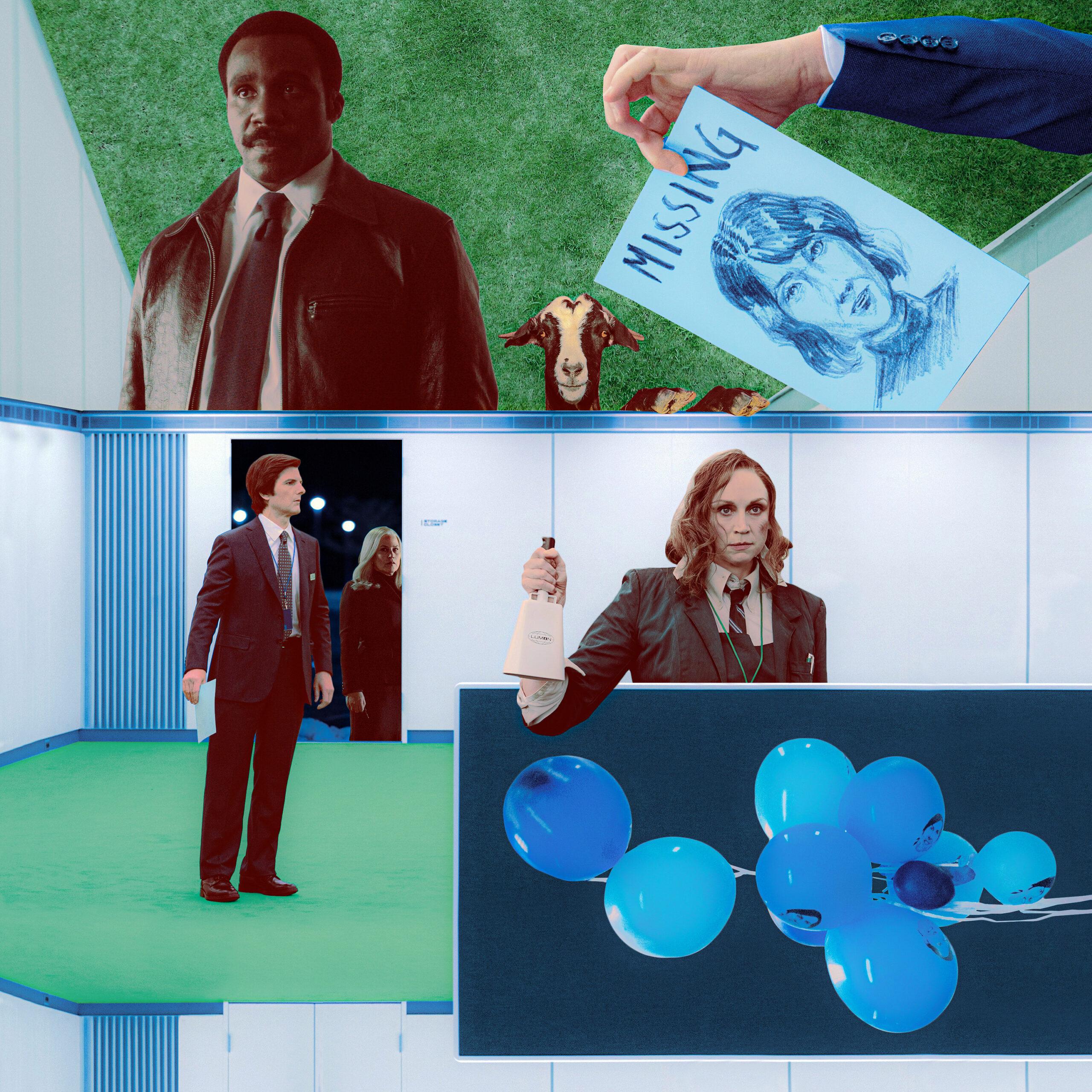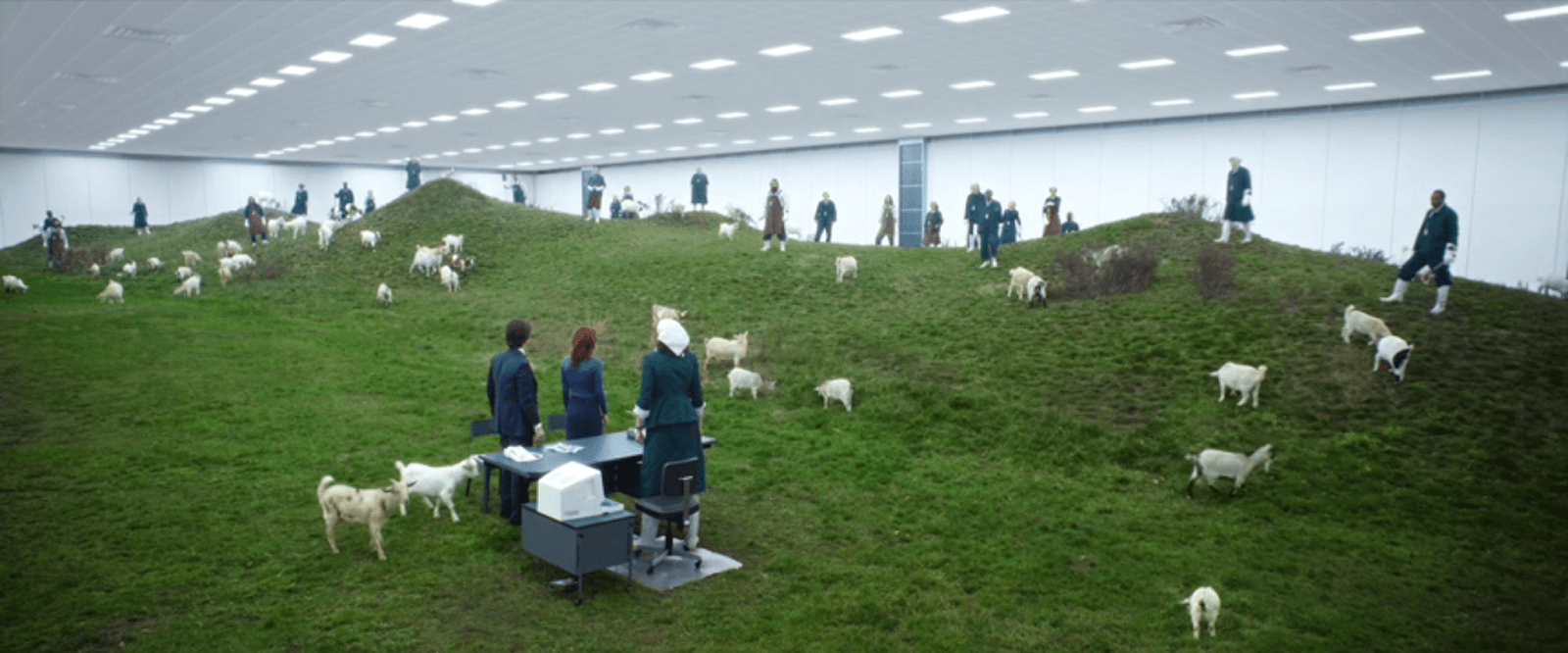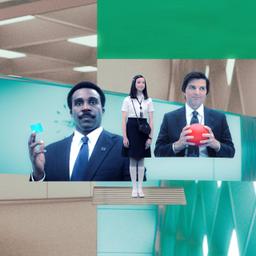

The music dance experience is officially canceled—but Severance returns. After three long years, the macrodata refinement crew is back on our screens. Follow along each week as we break down each episode of Severance Season 2. In the process, we’ll try to piece together what the heck is going on at Lumon Industries.
Crunching the Numbers
Not much macrodata was refined in Episode 3, but our understanding of Lumon’s severed floor was—albeit slightly, at best, because Severance parts with epiphanies more reluctantly than Lumon parts with perks. The MDR quartet goes on a walkabout this week, and though Christopher Walken is nowhere to be seen, Mark, Helly, Irving, and Dylan really explore the space, ranging far afield (in some cases literally) from their terminals as they make full use of their new hall passes and alleged freedom from surveillance. If Kier is right that the surest way to tame a prisoner is to let him believe he’s free, then the floor’s more rebellious innies are unwittingly being rendered as docile as the horned inhabitants of mammalians nurturable.
After opting to stay inside Lumon to track down Gemma/Ms. Casey, Mark and Helly (or Helena?) are eager to commence the rescue operation—Mark more so than Helly, who still has mixed feelings about her work crush’s search for his outie’s wife. They urge their colleagues to canvass the severed floor too, though the other MDR employees are less gung ho: Irving is hesitant to return to a Burt-free O&D, and Dylan is the one guy who’s trying to get the group project done while everyone else slacks off. (There’s always one.) Dylan, of course, has some special perks awaiting him, unbeknownst to his friends, which has made him more reluctant to rock Lumon’s boat.
Each of the innies returns to a previously visited location. And unlike Wellness, those locations aren’t “gone”—although the security room has already been transformed into the outie family visitation suite that Mr. Milchick teased in the Season 2 premiere. (Apparently, Lumon’s contractors work faster than those in our reality.) Dylan meets his outie’s wife, Gretchen G. (Merritt Wever), surrounded by a soothing sight- and soundscape of family photos, crashing surf, and squawking seagulls. It’s an ideal setting for a blind date with one’s sort-of spouse, aside from the fact that Lumon’s no-surveillance pledge doesn’t extend to quasi-conjugal encounters. “Please refrain from sharing information that may be privileged or sensitive,” Miss Huang scolds from a speaker when Gretchen mentions Mr. Milchick’s first name.
Irving finds O&D much the same as before, on a superficial level: Burt may be gone, but Irv takes solace in the company of Burt’s coworker Felicia, who offers the visitor a hug and fond remembrances of Burt. She also lets slip some intel on the elevator to the testing floor, after glimpsing a sketch of it in Irv’s notebook, buried behind nearly identical doodles of Burt. O&D doesn’t deliver directly to “the exports hall” anymore—Lumon sends someone to pick up shipments—but Felicia has the knowledge to take Irv to the haunting hallway or draw him a map.
Meanwhile, Mark and Helly set out to “find the goat man and other possible goat people.” Instead, they stumble upon an entire department with a very different dress code than MDR’s—and even more suspicion of strangers. The “goat people”—the members of mammalians nurturable, to you—are led by Lorne, who’s played by the great Gwendoline Christie. (The second season of Severance rivals The Bear when it comes to casting well-known actors in supporting parts.) Speaking of bears, the bruise on Lorne’s cheek evokes a battered Brienne of Tarth in the bear pit at Harrenhal: The goats look OK, but the human mammals seem worse for wear and in need of nurturing themselves. They won’t get any nurturing from Ms. Casey, whose whereabouts are unknown to them too. (Ms. Casey used to come by—she even reassured one worker that his outie excels at stargazing—but now, Lorne says with the weariness of someone who lives off the land, “We don’t abide such fripperies.”) That’s the bad news; the good news is that they let the two travelers live—and leave—after first menacing and threatening to report them. (To be fair, Mark and Helly were the ones trespassing on mammalians nurturable’s turf.)
Outside of Lumon, Ms. Cobel and Mark’s outie are also (separately) on the move. Ms. Cobel hits the highway and tries to put some distance between herself and the Eagans—until she hears the siren song of Lumon and follows it back to base. (Only to turn right around and leave again, following a fruitless verbal sparring session with Helena.) If anyone in this series seems to have an unhealthy relationship with work, it’s the woman Ricken dubbed “Cobelvig.” (Maybe she should sever.)
All of these plot points are a prelude to the most shocking development of the season so far. Mark Scout spends part of the episode hatching a scheme with his sister to communicate with his innie: By searing the episode’s eponymous question (“Who is alive?”) onto his retinas with a UV light, he hopes to create an afterimage that his innie will see after outie Mark’s two-minute-plus trip from the Lumon parking lot to the severed floor. This scheme, which Mark and Devon seem to have seen on the local equivalent of Yahoo! Answers or Quora, is doomed to be foiled by the brief pupil dilation that accompanies the descent. So instead, Mark decides to do something more drastic: He undergoes reintegration, guided by Asal Reghabi, the former Lumon surgeon we haven’t seen since Season 1, Episode 7.
Amid these momentous events, Ricken receives a commission from Lumon for an innie-specific rewrite of The You You Are. (The “remarkable” original is “so astute,” board liaison Natalie raves; “That’s what I was going for,” Ricken confirms.) More memorably, Mr. Milchick gets a gift from the board: a race-swapped series of artworks, called the Keir Cycle, that features a black-faced, blue-eyed Keir Eagan. It’s an off-putting, pandering, appropriative attempt at corporate inclusivity (or something). “Oh. Oh, my,” says Mr. Milchick, which just about sums it up. Lumon’s management could be canceled for this cringeworthy gesture if anyone knew who, what, or where the board might be.
After two episodes that were severed by setting, with innies claiming the premiere and outies relegated to Episode 2, “Who Is Alive?” reintegrates the series’ story lines along with Mark’s multiple personas. More locales and more characters mean more narrative territory to cover in our recap, so let’s cautiously proceed to the next section.
Careful, there’s poop.
Unanswered Questions
What’s a mystery box show without them?
What’s the purpose of mammalians nurturable?
We got some good goat time in this week, but Severance’s animal analogues to Lost’s polar bears remain almost as inscrutable as ever. Twelve episodes in, we still don’t know what refining accomplishes, so it’s no surprise that we wouldn’t immediately learn what a department we just discovered does. I don’t know about you, but I kinda think Lumon might be up to something. We can speculate about what in the next section.
Is having an emotional affair with your severed spouse’s innie cheating?
Look, I want to know what Lumon’s up to as much as the next Severance watcher, but I wouldn’t want to reduce the series to a puzzle that exists to be solved—not if theory crafting comes at the expense of appreciating the series’ aesthetics, acting, comedy, and weirdness along the way. The eventual revelations probably won’t live up to the theorizing anyway: At this point, the possibilities for the series are legion, but by the end, Severance will have to settle for a single storytelling lane, which will inherently lead to regret about roads not taken. “I’ll read all these theories that are different from what we’re actually going to do,” creator/writer Dan Erickson said recently. “But I’ll be like: ‘Damn it, that’s pretty good. I wish I could make that show, too.’”
Erickson also insists that he’s learned from Lost’s example and that Severance won’t leave viewers unfulfilled. The writer’s reassurances are heartening, but it’s tough for anyone to trump the power of millions of imaginations. Odds are either the solutions to the mysteries won’t be as satisfying as we’ve convinced ourselves they could be, or they’ll be exactly the sort of solutions we’ve envisioned, in which case all the theorizing will essentially have spoiled some of the series’ long-anticipated disclosures. Thus, what will likely stick with me more than particular twists are the series’ philosophical questions about the nature of identity, which can’t be answered definitively by the people who posed them. Each viewer must decide such answers for themselves. The most compelling part of watching Severance isn’t trying to outthink Erickson but straining to put ourselves in the place of a severed person. (As Devon did in the Season 1 finale, when she asked Mark S., “Do you understand metaphor?”) And the fledgling connection between Dylan G. and Gretchen sets up one of the series’ richest ethical conundrums.
It’s safe to say that none of the MDR innies is a smooth operator romantically, yet each of the four has found some spark inside Lumon: Irv with Burt, Mark and Helly with each other, and Dylan G. with Dylan George’s wife. Just as innie Mark whiffs this week on a chance to smooch Helly, Dylan doesn’t know how to handle Gretchen’s warm embrace. In Mark S.’s defense, the innie has never initiated a kiss. (Helly, however, seems expectant—which might bolster the case that this is really Helena, looking for a little of the Mark S. action Helly had.) And in Dylan’s defense, who would know what the proper protocol is in such a strange situation? Yet despite the awkward circumstances, the ice thaws quickly, and Dylan seems as smitten as a schoolboy (which Zach Cherry plays with perfect, poignant naivete). Gretchen and a different Dylan have been married for years, but maybe she and this Dylan are about to be in the honeymoon phase.
Gretchen, who—based on her scene outside Lumon—seems to be a night watchwoman (or something of the sort), seems intrigued by this innocent hard worker who looks like her husband. Dylan G. can hold down a job, and Gretchen doesn’t deny that his outie is “kind of a fuckup.” What if Gretchen can’t deny her attraction to this second, more dependable Dylan? (His innie and outie may have different memories, but their pheromones are the same.) And what if Dylan G. decides that he deserves more than merely 18 minutes in heaven with his outie’s wife? Isn’t it unfair that his ne’er-do-well outie gets to reap the rewards of Dylan G.’s labor? There may be two bodies involved in this liaison, but there’s a throuple’s worth of envy just waiting to be unleashed. Let’s just hope that Miss Huang will stop eavesdropping if a future rendezvous gets more intimate.
Honestly, it seems like there should be more sex on Severance—if you were trapped on the severed floor, with nothing to anticipate but a series of almost indistinguishable workdays, wouldn’t sex seem like an irresistible diversion or a more appealing alternative to getting on an elevator that brings you right back to the beginning of your shift? On the other hand, hooking up with a coworker has the potential to get even messier in a scenario where neither party is allowed to leave the office.
What makes Ms. Cobel come back?
Maybe the prospect of a 238-mile drive to Salt’s Neck(?), with only an old radio and monotonous, tundra-like terrain for entertainment, sends Ms. Cobel back to Lumon. But her flip-flop seems more motivated by her companion on the passenger side: the medical apparatus that formerly occupied pride of place on the in-home Kier shrine in her house, which we saw last season during the “waffle party” montage.
Why does she, well, waffle now? It could be because the green device, which series set decorator Andrew Baseman described as “an oxygen tube from her mother’s last breath,” reminds her of a debt to Lumon. Did Kier’s company’s equipment prolong the life of Charlotte Cobel? Or is that just what she’s been led to believe? The Severance e-book published alongside Season 1, The Lexington Letter, includes a reference to a newspaper’s “well-sourced exposé on Lumon’s feeding tube devices,” which was quashed when the outlet “got sued into oblivion and folded six months later.” Maybe Charlotte was a victim; little at Lumon is what it looks like.
Whatever Cobel’s reasons are for returning to company headquarters, her second conference with Helena goes worse than the first. Cobel more or less labels Helena a nepo baby; Helena retorts, “I think you’ve overestimated your contributions and underestimated your blessings.” Helena seems to set up a meeting with the board about Cobel’s job, but her veiled threat about Lumon not needing Cobel, coupled with the looming presence of a security stooge, spooks Cobel into a strategic retreat. Helena, ironically, calls out “Harmony” as Ms. Cobel beats feet and burns rubber; clearly, there’s nothing but discord between Helena’s company and Cobel. Maybe the ex-overseer of the severed floor has cold feet about Cold Harbor. But even if Cobel quits Lumon, it seems unlikely that she can quit Mark.
How does Natalie actually feel about Lumon?
I’d love to know whether Lumon’s mouthpiece, Natalie, repeats precisely what the board tells her or whether there’s some degree of interpretation involved in her syntax. Lumon has a weird way with words, as evidenced by such curiously stilted turns of phrase as “The board austerely desires for you to feel connected to Lumon’s history” and “Please accept from the board these inclusively recanonicalized paintings.” More than that, though, I want to know whether her fixed, hyper-perky smile is forced or sincere. When the board concludes the call and Milchick—sorry, Seth—silently looks her in the eye, the mask seems to slip, or at least slightly waver. Natalie may be the face of the board, but that blissed-out face is a front. And why wouldn’t it be when her bosses put not only words but emotions in her mouth? “The board wishes to express that I, Natalie, received this same gift upon receipt of my current position—and found it extremely moving.”
(The Lumon board’s communication method reminds me very much of the way “management” communicates in a similar—and similarly excellent—sci-fi series, Counterpart, which would have been a bigger hit if it had aired on a more visible network than Starz. If you need another series that scratches your Severance itch—maybe during the next extended break between Severance seasons—do yourself a favor and catch up on Counterpart, which also incorporates old-school computers, striking settings and designs, and thought-provoking questions about split selves.)
Mr. Milchick’s day started on a down note—he was mad that Mark abandoned his balloons—and it headed downhill from there. It’s hard to feel bad for the Eagans’ taskmaster, but from Helena and the board’s continued negotiations with the floor’s former supervisor to the terrible tech support he received when his screen was still greeting Ms. Cobel to the offensive spectacle of Kier in blackface, it’s clear that he’s a cog in the Lumon machine—not a severed employee but valued little more (or maybe less) than those who are. Perhaps Lumon’s disregard will one day cure him of his cruelty and set up a Mr. Milchick redemption arc. Then again, middle managers with just a taste of power sometimes make the most tenacious, sadistic enforcers.
How will Mark’s reintegration work?
It’s no surprise that Reghabi is back or that the former Lumon surgeon, who claims to have performed Mark’s severance procedure, is keen to try to reintegrate him. (Reintegration sorta seems like a misnomer; the process integrates an outie with an innie who never existed prior to the severance.) The real surprise is that it’s seemingly happening so soon. Severance may be a mystery box, but it definitely doesn’t seem to be paddling in place or stringing its audience along. Even if we accept that Reghabi isn’t a Lumon operative tasked with ensnaring troublesome outies, she definitely doesn’t seem to be bound by the Hippocratic oath. Yet Severance’s no. 1 wife guy needs no convincing to undergo the risky procedure as soon as Reghabi backs up Devon’s innie-inspired hunch that Gemma is still alive.
Given that Mark is the main character, he probably won’t go the way of poor Petey. But an unprecedented successful unsevering would substantially alter the story. How would fusing married Mark and single-and-ready-to-mingle Mark affect his innie’s budding romance with Helly? Would he level with his work pals, serve as an intermediary between the MDR innies and their outies, and encourage some of the other outies to reintegrate? Would he tell Helly about Helena? And would he call out Helly—if that was Helly, not Helena—for lying about her outie experience in the premiere? Could he fool Mr. Milchick into thinking he’s the same old Mark S.? How would Devon feel about her brother being a blend of Mark Scout and the virtual stranger she met during his 39 minutes of “overtime”? A melded Mark would be such a destabilizing development for the series that I won’t totally trust that the reintegration will stick until we see it. The show is called Severance, not Reintegration, after all.
What is Cold Harbor?
Aside from a lopsided Civil War battle, I don’t know. These are unanswered questions, remember? All we can say for certain is that it has something to do with Gemma/Ms. Casey and that Mark S. is “so close to completing” it. Add the term to the long list of water connections in Severance—unless the “harbor” in question refers to a body that could be a repository for another consciousness. Maybe a body kept in cold storage on the testing floor.
Reddit Theory of the Week
This isn’t so much a new theory as it is an old one that this episode doesn’t undercut (though it doesn’t quite corroborate it, either). For years, fans have conjectured that the goats are related to a Lumon cloning project, which the show’s cast, um, cast cold water on in an Entertainment Weekly video published this month. Fine: Maybe Mickey 17–style cloning is too trite, then. If it’s not cloning, it could be consciousness transfer: a way of bringing back Kier, maybe, or ensuring that the surviving Eagans (and any other bigwigs who can pay for the procedure) don’t die but “revolve.” In that case, the goats could be test subjects.
For what it’s worth, the sight of Mark and Helly crawling through the chute the goats take to their grazing area—if Helena wasn’t fetid before, she will be the next time she leaves Lumon—reminded me of John Malkovich crawling into his own head in Being John Malkovich. (Which is appropriate, given the visual of mini-Mark leaping into his own brain in the opening credits.)
“Have you come to kill me?” Lorne asks Mark and Helly, sounding unsurprised. She doesn’t yet know that they’re from MDR; is she expecting someone else to kill her? Maybe the goatherds are disposable test subjects too, which could account for their condition. Lorne soon summons reinforcements, who eerily emerge from the landscape in one of the most unnerving moments in Severance so far (which is saying something). Ultimately, Mark and Helly try to save their own skins by appealing to the goatherds’ sense of severed solidarity—and, when that doesn’t work, their sense of sympathy for stray goats, which Mark likens to Ms. Casey. Mammalians and refiners agree to part in peace. But before these newfound neighbors bid goodbye to Mark and Helly, they make a peculiar request: “We would like to see your bellies.”
At first, I thought the goatherds’ desire to see Mark’s and Helly’s bellies was about belly buttons: Clones, decanted instead of detached from umbilical cords, wouldn’t have them! But no: This was a callback to the scuttlebutt about MDR that Burt shared in Season 1. “They say you all have pouches,” he sheepishly shared, adding, “According to some, you each have a larval offspring that will jump out and attack if we get too close. … In this theory, the larva eventually eats and replaces you.”
Mark and Helly predictably pass the pouch inspection. “See? Pouchless,” Lorne says. (Her companion pouts, “Proves nothing.”) But maybe that tall tale about larvae contains a kernel of truth, distorted through repetition or a company-created whisper campaign. Perhaps MDR is unwittingly working on a way to take control of and replace a person.
Employee of the Week: Dylan G.
If something along those lines happened, or is happening, to Gemma—if the body of Mark’s wife has been hijacked by another mind—then the completion of Cold Harbor could be cold comfort to Mark. For now, we’ll wait and wonder. Maybe Kier would want us to feel the warm embrace of knowledge and truth, but the creators of Severance don’t—not yet, at least.
Dylan had a banner day. Imagine clocking in for another shift of staring at mysterious numbers on a screen, receiving an ominous summons from your young supervisor, and then suddenly discovering that (a) Merritt Wever loves you, (b) you have a bunch of cute kids, and (c) you don’t even have to worry about baking cookies for them to take to school. All of the children, none of the childcare! Not that you would mind baking cookies or being the kind of caretaker who doesn’t use screens to babysit—I, the world’s most attentive, conscientious dad, would know nothing about relying on cartoons to parent like outie Dylan does—because (d) you’re much more industrious than your outie. All along, you’ve wondered what your outie is like. Now you find out that you’re the one with your shit together.
Is Dylan being a supportive, forthright friend by hiding his little love nest and declining to look for Ms. Casey? Clearly not. But this category isn’t called Friend of the Week. Dylan is hitting his quotas—at least someone’s serving Kier; macrodata doesn’t refine itself—and obfuscation is the Lumon way. After all, “wiles” is one of the Core Principles. (So is “probity,” by the way, which seems somewhat inconsistent. Take it up with Kier if somehow he returns.)
Design Porn
Severance isn’t just a story; it’s an atmosphere. Each week we’re highlighting our favorite looks captured by the show’s eerily gorgeous production design and cinematography.


Speaking of austerity: Severance is famous for its minimalist and largely colorless interiors. Compared to the ascetic, confining corridors of most of the severed floor, the verdant hillocks of mammalians nurturable must make it look like a dazzling, wide-open space. Remember, Mark S. and Helly R. haven’t seen the sky, so that high ceiling and emerald expanse below must be magical. OK, so the presence of creepy goatherds who materialize like the Whisperers from The Walking Dead probably puts a damper on one’s desire to break into song. (♪ The hills are alive with some scary goatherds … ♪) What I want to know is, how do they get the grass to grow so well with no natural light? Lumon manufactures its own doors; does the company also supply its own industrial-scale grow lights? I wouldn’t put it past the Eagans. What don’t they make?





